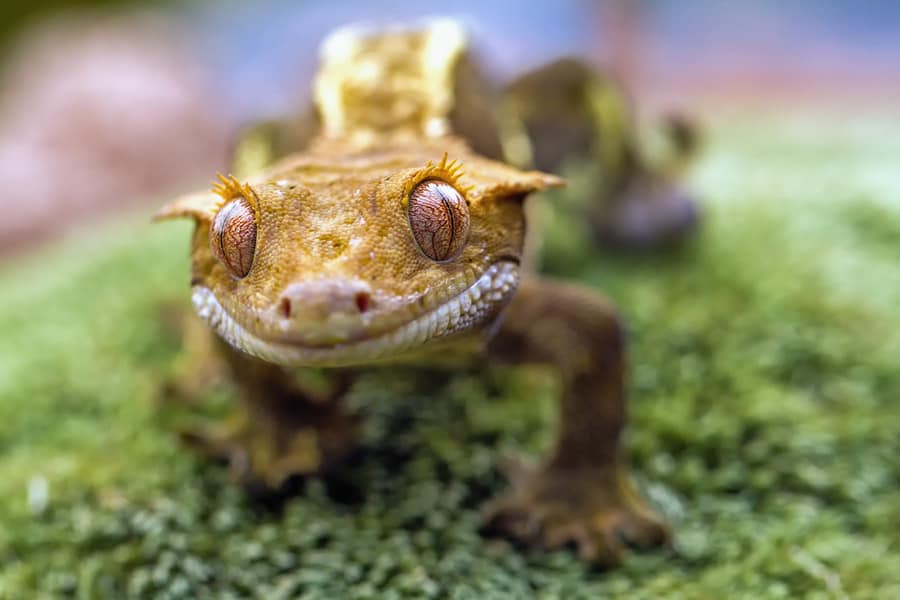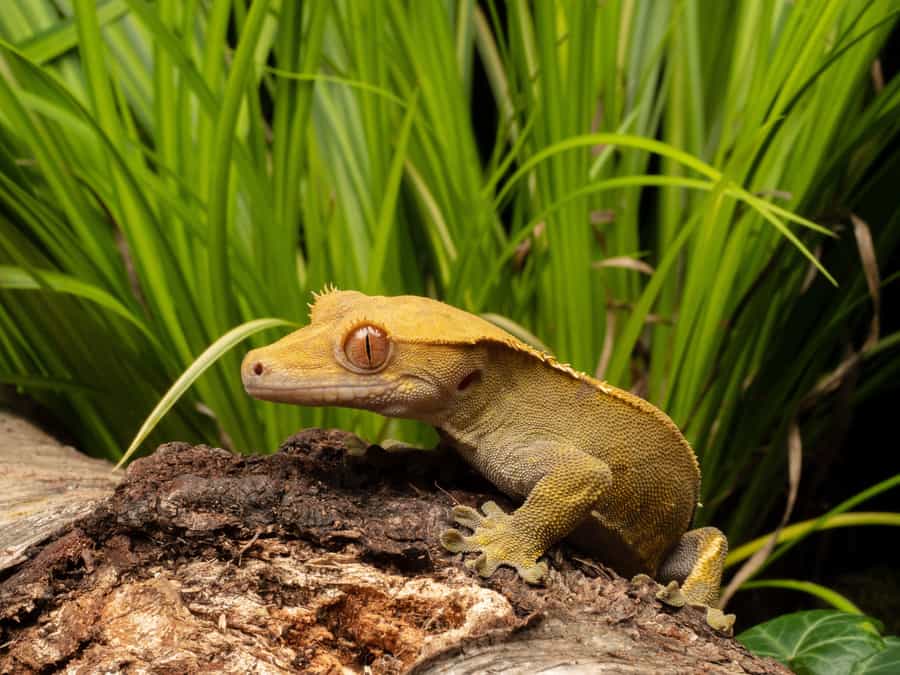
Crested Geckos are beautiful pets that every owner would love to handle. The question you may ask is, “do these reptiles love it when you hold them?” You should know the answer to that question to keep your gecko comfortable.
Crested geckos tolerate handling very well compared to many other similarly sized pet reptiles. With care and mindful practice, you can train a crested gecko to become very accustomed to daily handling.
Before diving into more details, it’s imperative to know that pets generally prefer being handled in comfortable environments. So, you need to ensure that you keep their vivarium clean and at the appropriate temperature. Keep reading to know more about handling your crested geckos.
Crested Geckos & Being Handled
There’s a lot to know about handing your crested geckos, including the perfect time and appropriate body region to touch. If you’re new to owning this gecko, there are essential techniques and tips to comprehend. You should know the type of gecko you have before determine the appropriate way to handle your pet.
Geckos are great to handle, but you should watch out for how they behave when you try. Some may squirm, nip, and try to run from you when handling. If you observe any form of discomfort when trying to handle your gecko, it’s essential to exercise caution. Reluctant geckos can harm themselves, especially when you’re trying to handle them forcefully.
When handling geckos, they mustn’t fall to the ground. Most crested geckos tend to lose their tails when they experience a fall from certain heights. The effect of a fall varies, depending on your type of floor. If you have ceramic, concrete, or a wooden floor, their fall may be harmful.
You should be more careful when handling baby crested geckos or the gravid female ones ready to lay eggs as an owner. If you’re handling your gecko, the most suitable way to do so is around a safe environment. You should be ready for a scenario where your gecko may become reluctant.
Do Crested Geckos Like Being Handled?
Crested geckos like being handled and they often like it gently. Due to certain factors like trust, some of these reptiles also don’t like owners handling them. If your geckos don’t like being handled, you shouldn’t disturb their serenity. You can touch and handle your geckos once a week, especially when you’re cleaning up their vivarium.
One of the most important questions you should also ask is, “do you need to handle them?” Most times, owners like to hold their geckos in their hands to create a good relationship. According to the Centers for Disease Control and Prevention, handling pets can help in decreasing blood pressure, cholesterol levels, and feelings of loneliness.
Owners usually want to hold their crested geckos for any of those benefits. If those are your reasons, then you may need to handle them. However, it’s essential to note that these reptiles don’t necessarily need to be handled. You can decide to hold them only when you feel the necessity to move them.
As an owner, you may fall under the category of those that want to handle their geckos. For this reason, you must learn the different techniques to hold these animals effectively.
To learn if crested geckos can be overfed, please check out this helpful article I wrote.
Benefits of Handling Crested Geckos
There are various advantages of handling crested geckos to the reptile and owner. Apart from the general benefits of handling a pet, there are specific benefits that you should note. Here are some of the significant upsides of handling crested geckos:
- Building Trust: When you handle your crested geckos often, it builds trust between you and the reptile. There’s a high tendency that your gecko will be reluctant at the first try but will be more accommodating with time. Once your gecko can trust you for handling, then you’re building a good relationship with them.
- Hand walking: If your geckos are comfortable with you holding them, they may attempt to walk on your hands. They practice hand walking when they move from one hand to the other. Continuous hand walking keeps your gecko calm and comfortable when around you.
- Jumping: Holding your crested gecko helps them to practice their natural jumping abilities. These animals are great jumpers and love doing that at significant distances.
- Making easy observations: When you handle your gecko often, you can make certain imperative observations. You may have the ability to discover stress or any form of irregularity. Overall, you can make essential observations about your gecko’s health.
How to Tell if Crested Gecko is Open to Handling
Before handling your crested geckos, it’s important to know if they are ready. These pets give visible signs in some scenarios that help you discover whether it’s time to handle them or not. One of the most imperative things to note is that these reptiles need time to adapt to their environment before handling. Once your gecko is comfortable with the surroundings, handling wouldn’t be a challenge.
After giving your crested gecko time to settle (two weeks), you can start to take some steps to observe its readiness. Try to handle the gecko once a week during clean-ups. If you observe that they are always reluctant after two weeks of handling, you shouldn’t force it.
Geckos need time to trust their owners, and for this reason, you should be easy on them. A gecko that isn’t reluctant during cleaning sessions is open for handling.
How to Handle Crested Geckos
For safety purposes, you must understand the appropriate technique to handle your pet reptile. Following some intentional tips and methods is highly advisable to keep your gecko safe. Here are some of the significant tips to follow for proper handling of your gecko:
- Avoid handling them immediately you bring them home: Before you begin to handle your crested gecko, one of the most important points to note is you should give them time. Most geckos may be reluctant when owners try to handle too early, and this may ultimately cause harm to them.
- Reduce stimuli around before handling: Too many stimuli around your gecko will cause stress or fear. For example, try avoiding the presence of too many people or loud music. If you bombard your gecko with loads of stimuli, you’re only reducing the reptile’s trust. In most cases, an initial poor handling experience may discourage them from further handling.
- Be watchful of your crested gecko’s tail: It’s easy for a crested gecko to lose its tail. When geckos feel threatened or scared, these reptiles usually lose their tail. If you pull your gecko’s tail by mistake during handling, they may lose it. Hence, always be mindful of their tail.
- Keep them close to the ground: You should want to keep your gecko safe from harsh impact or injury, especially to its tail. For this reason, ensure that the geckos are not far from the ground when you handle them.

Signs Your Crested Gecko is Stressed
If your gecko’s environment is unsuitable, this will cause stress. Crested geckos show visible signs of stress, and there are ways owners can recognize these signals. Here are significant signs to look out for to know whether your gecko doesn’t want to be touched anymore:
- Heavy breathing: When you handle your pet and observe heavy breathing, it’s a valid sign of stress. It’s advisable to stop handling immediately and keep your crested gecko in the vivarium. Don’t confuse heavy breathing with sniffing. The latter occurs when you have new objects on your hands.
- Running from the owner: One of the most evident signs of stress is when your gecko runs from you when you try to handle it. If you forcefully hold the gecko, you may observe consistent efforts to break free. Stop handling your gecko when you observe this sign of stress.
- Firing up: This state defines a gecko that becomes very bright colored. Most times, this condition occurs after shipping stress or handling. In an appropriate scenario, geckos should fire down after a while. Hence if your pet doesn’t become dull, you should consult a vet doctor.
- Tail drop: Your gecko may experience tail drop due to high levels of stress. Note that a tail drop is originally a defense mechanism meant to distract the predators. For this reason, you should review your gecko’s environment or see a vet when you observe this sign.
How to Pick Up a Crested Gecko
There’s a technique to follow when trying to pick up a crested gecko. Following all the necessary steps will fortify your gecko’s trust in you as an owner and ensure safety. Here’s a step-wise approach to adhere to when picking up a crested gecko:
- Ensure your hands are calm: If your gecko notices you aren’t calm when touching, they may become reluctant. Your hands shouldn’t shake when trying to pick up a crested gecko to ensure that you have a good grip.
- Slide your hands through their base: The best technique for lifting your gecko is to start from the stomach region. Don’t lift your gecko through the tail. If you pull their tails too hard, they will lose it. Note that crested geckos don’t grow back their tails after a loss.
- Lift gently: Avoid lifting your gecko too fast. It would be best if you were delicate with these reptiles to make them develop trust in you. Make gentle movements that wouldn’t stress them out.
- Put a hand in front of the other for hand walking: If you need the pet to move from a hand to another, stretch out your other palm. Owners who want to see their pets jump should ensure that the palm isn’t too close to the gecko.
For a complete breakdown of the health impacts of crested geckos shedding their tails, check out this article.
How Often Should Crested Geckos be Handled?
It would be best if you handled your crested gecko four to five days a week. As a start, handle them for five minutes and increase the duration with time. When your gecko gets more familiar with you, it’s safe to increase your handling time to fifteen to twenty minutes every day.
The frequency of handling your gecko depends on a lot of factors. One of the most important points that determine your handling duration is the environment. If your gecko finds the environment uncomfortable due to noise or the number of people around, handling will not take long.
Over-handling your gecko is never advisable. For this reason, owners should consider sticking to a schedule. If you also observe stress in your gecko while handling, ensure they get into the vivarium. An average of fifteen minutes per day may be good enough, even if your gecko trusts you. Most crested geckos get restless or jumpy when they need to return to their habitat.
The main goal of handling is to ensure that your crested geckos are very comfortable in their environment and around you. Hence, it’s important to avoid doing that for long during the day or too much in the week.
Crested Geckos Compared to Other Popular Pet Lizards
Crested geckos are different from other conventional pet lizards. They all share common physical features but have distinct behavioral patterns. Here’s a list that differentiates the tolerance of unique pet lizards compared to crested geckos:
- Crested Geckos vs. Bearded Dragon: Compared to crested geckos, bearded dragons are more sociable and enjoy having to contact their owners. For this reason, you may observe that bearded dragons can be handled for long periods.
- Crested Geckos vs. Leopard geckos: Leopard geckos may be solitary animals, but they also enjoy handling. They are also more tolerant in the early days than the crested geckos because they are docile and calm.
- Crested Geckos vs. Blue-Tong Skink: These types of lizards are curious. They are very similar to the crested geckos because they don’t react well to loud noises or sudden movements.
- Crested Geckos vs. Green Anoles: Green anoles are shy reptiles, making them equally complicated to handle like the crested geckos. They prefer not to be handled frequently.
Are Crested Geckos Clean?
Crested geckos are clean reptiles. However, they aren’t entirely clean reptiles. As an owner, you need to ensure that you keep their enclosure in a perfectly clean condition. These reptiles may have bacterial infections but wouldn’t appear ill.
Most geckos poop on the palm of their owners during handling, which is quite messy. Due to the nature of crested geckos, they may not require any special body care. However, it’s imperative to take care of their surroundings.
It would be best if you didn’t bathe your crested geckos. These pets can take good care of themselves. Keeping your gecko under an appropriate humid environment and other right conditions is good enough. Note that if you try to bathe your gecko, you may cause stress.
Final Thoughts
Most pet lizards are straightforward to handle, including the crested gecko. One of the most important factors to always consider is the gecko’s environment and comfortability. Any form of discomfort in your gecko will make handling difficult. With a good idea of what it takes to handle a crested gecko, you can get as many as you require.
For a complete breakdown of how reptiles bond with their owners, please check out this helpful guide.
